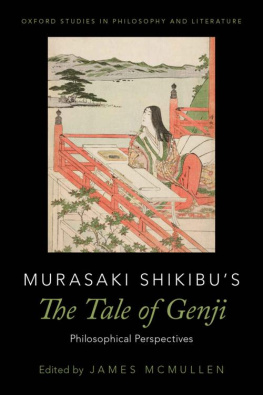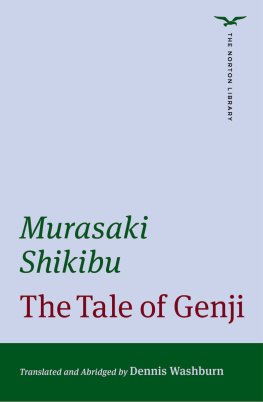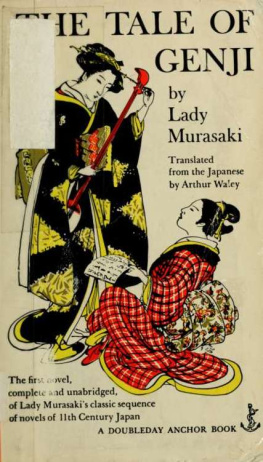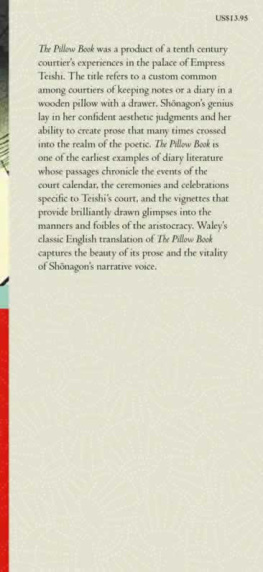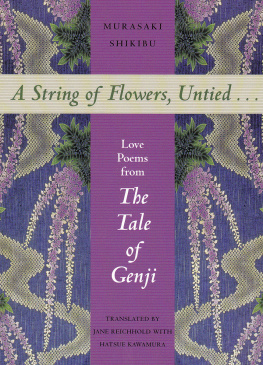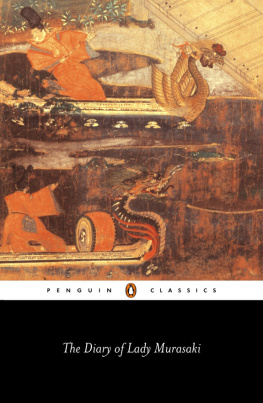Shikibu Murasaki - The Tale of Genji (unabridged)
Here you can read online Shikibu Murasaki - The Tale of Genji (unabridged) full text of the book (entire story) in english for free. Download pdf and epub, get meaning, cover and reviews about this ebook. year: 2015, publisher: W. W. Norton & Company, genre: Art. Description of the work, (preface) as well as reviews are available. Best literature library LitArk.com created for fans of good reading and offers a wide selection of genres:
Romance novel
Science fiction
Adventure
Detective
Science
History
Home and family
Prose
Art
Politics
Computer
Non-fiction
Religion
Business
Children
Humor
Choose a favorite category and find really read worthwhile books. Enjoy immersion in the world of imagination, feel the emotions of the characters or learn something new for yourself, make an fascinating discovery.

- Book:The Tale of Genji (unabridged)
- Author:
- Publisher:W. W. Norton & Company
- Genre:
- Year:2015
- Rating:3 / 5
- Favourites:Add to favourites
- Your mark:
- 60
- 1
- 2
- 3
- 4
- 5
The Tale of Genji (unabridged): summary, description and annotation
We offer to read an annotation, description, summary or preface (depends on what the author of the book "The Tale of Genji (unabridged)" wrote himself). If you haven't found the necessary information about the book — write in the comments, we will try to find it.
The Tale of Genji (unabridged) — read online for free the complete book (whole text) full work
Below is the text of the book, divided by pages. System saving the place of the last page read, allows you to conveniently read the book "The Tale of Genji (unabridged)" online for free, without having to search again every time where you left off. Put a bookmark, and you can go to the page where you finished reading at any time.
Font size:
Interval:
Bookmark:

Contents
D URING THE first decade of the eleventh century Murasaki Shikibu, a woman born into the middle ranks of the aristocracy in the Heian period (7941185 CE ), began writing a fictional narrative that was recognized by her contemporaries as distinctive and remarkable even as it was being composed. Expansive in form, compelling in its delineation of character, sophisticated in its representation of ethical concerns and aesthetic ideals, Genji monogatari would come to occupy a central place in one of the worlds most important literary traditions. Over the past millennium readers from vastly different eras and social backgrounds have discovered in its depiction of the culture of the imperial court a profound understanding of human experience that simultaneously resonates with and challenges their own.
One measure of its achievement as art is that, like the Homeric epics or the tragedies of Shakespeare, Genji monogatari has been able to inspire multiple interpretations over a long period of time. Yet the history of the works critical reception also raises questions about how contemporary readers should approach the narrative. Does prior knowledge of its privileged place in Japanese culture help or hinder our understanding? Can we ever fully appreciate a text that chronicles the concerns of a society so radically different from our own? Is it possible to read with an open mind a text around which so much scholarly, ethical, and even political discourse has accumulated?
The canonical status of any work of art is the outcome of an ongoing evaluation of the ways an artist utilizes the possibilities for expression intrinsic to his or her chosen medium. This means that such status is dependent on the extrinsic values and agendas of particular readerships at different historical moments. Widely accepted judgments made in one era leave their traces in some form or other in the next, affecting the evolving discourse a culture has about itself. Quite often these judgments acquire institutional, ideological, or pedagogical force, especially when knowledge of a work is imagined to be a vital part of cultural literacy and thus essential to the formation of ethnic or national identity. Yet to read Genji monogatari with a critical mind-set that does justice to the text as a work of art requires a skeptical attitude toward its privileged position. Readers who come to it through a translation such as this one must recognize (at least in the abstract) that its perceived cultural significance depends as much on the many layers of annotation and interpretation that surround the original text as on its purely literary qualities. In addition, readers must situate the history of the reception of the work in a comparative contextone that accounts for the social and cultural conditions that have produced not only past interpretations but also contemporary expectations and tastes. Simply assuming the canonical status of the workthat is, being lazy or indifferent readersprovides an excuse to ignore the parochial limits of our own aesthetic preferences. Of course, we can never completely step outside the ideologically determined values and literary conventions that ground our interpretations; but if we at least remain attentive to questions about how and why Genji monogatari has achieved canonical status, then through such critical reflection we can open ourselves more fully to the challenges and pleasures presented by Murasaki Shikibus art.
Readings and receptions of Genji monogatari in Japan
TO GET a sense of the importance of reading with a critically open attitude, with a willingness to negotiate between the cultural assumptions that shaped the text and those that shape our expectations of it, we need to consider briefly how previous generations have approached the narrative. Written in the vernacular of court society, Murasaki Shikibus vivid depiction of the world inhabited by her fictional hero, the Radiant Prince Genji, drew directly upon the realities of the lives of the aristocracy, providing the men and women who first read her tale with the shock of the familiar. The imperial palace and the bureaucratic institutions that supported it constituted a realm inhabited by the most privileged of an elite classone that was aloof and isolated, disdainful of the lower orders, and extraordinarily self-absorbed. Genji monogatari satirizes the foibles and hypocrisies of the nobility, especially as these are exposed in the course of relationships between men and women, while at the same time reinforcing or affirming fundamental aesthetic, moral, and religious values in a way that was flattering to the self-regard of court society. It is no wonder, then, that the earliest portions of the narrative found an avid readership among the authors peers, and that the initial reception of those first chapters likely paved the way for the author to enter court service in the salon of Empress Shshi, where she probably completed the bulk of her masterwork.
Within a decade of its composition Genji monogatari began to circulate more widely outside the confines of the imperial court, and over the course of the following century emaki versionsscrolls containing both text and illustrationswere produced. However, because no manuscripts from the early eleventh century have survived (the earliest surviving fragments of emaki date from the twelfth century), it is impossible to say with any certainty to what extent copies were available at the court. Judging from comments found in Sarashina nikki, a journal (or diary) written in the mid-eleventh century by a woman known to us as the daughter of Sugawara no Takasue, it was difficult to obtain the complete text if you were outside the court. Few copies were readily available, and individual chapters often circulated separately. Thus, even though the readership of Genji monogatari was limited during the early part of the eleventh century, it is clear from the account presented in Sarashina nikki that the reputation of the work quickly spread beyond the confines of the elite court nobility who worked in and around the imperial palace. Taking full advantage of stylistic techniques that had been developing for well over a century in Japanese prose (not just fiction but diaries, chronicles, and journals as well), Murasaki Shikibu crafted a narrative voice that was forcefully persuasive and often knowingly ironic. She also conjured through her writing the illusion of an internal reality or subjectivity within her characters. In turn, these rhetorical achievements had broader cultural implications. The articulation of a well-defined aesthetic sensibility in Genji monogatari through the subjectivity of characters who are consciously, often painfully, torn between the fleeting appeal of material, secular culture and a religiously motivated desire to escape worldly attachments revealed the contradictory nature of the dominant values at the court in mid-Heian Japan. Over time this conflicted aesthetic sensibility proved so appealing that it became a central element in what has long been regarded as a distinctive Japanese ethos.
Although the economic and political power of the court gradually contracted over the course of the eleventh and twelfth centuries, the powerful military clans that came to dominate Japanese society from the twelfth to the nineteenth centuries did not reject the courtly aesthetics exemplified by the characters and narrative stylistics of Genji monogatari. Many of the cultural artifacts the contemporary world now almost instinctively associates with the traditional Japan of medieval societylandscape architecture and the tea ceremony, ink monochrome paintings and rustic ceramics, ikebana and the martial arts, linked verse and the Noh drama, to name a feweither developed directly out of artistic forms produced by the aristocratic class of the Heian period, or were inspired by a desire to emulate the sensibility of that class. At the same time, medieval interpretations of
Next pageFont size:
Interval:
Bookmark:
Similar books «The Tale of Genji (unabridged)»
Look at similar books to The Tale of Genji (unabridged). We have selected literature similar in name and meaning in the hope of providing readers with more options to find new, interesting, not yet read works.
Discussion, reviews of the book The Tale of Genji (unabridged) and just readers' own opinions. Leave your comments, write what you think about the work, its meaning or the main characters. Specify what exactly you liked and what you didn't like, and why you think so.


